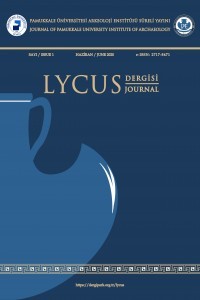Tripolis ve Büyük Menderes Nehri
The Büyük Menderes River, which plays an important role in the formation of the geomorphology of Western Anatolia, has been a factor directly affecting the life established on the geography where it has been located for millennia. In the case of Tripolis, the importance of the Büyük Menderes River and the archaeological excavations that have been going on for ten years, our knowledge and views on how the trade of the city may have been shaped by the role played by the Büyük Menderes River are increasing day by day. In this study, we have tried to convey our views and information about the city's connection with the Büyük Menderes River and its dominance over the river and the valley formed by the river. As a result of the archaeological excavations, it has been revealed that Tripolis, located within the borders of the Lydia Region, has been intensively involved in commercial activities since the Late Hellenistic and Early Roman Imperial Periods. Both written sources and archaeological data show that Tripolis had a significant share in interregional trade. The fact that the city was built on a hill close to the fertile lands of the Menderes Valley allowed it to dominate the fertile agricultural lands irrigated by the Menderes River. It is understood that the city used the conveniences provided by its geopolitical position in a very efficient way, and it shows that the city also benefited from all the opportunities offered by the Büyük Menderes River.
Anahtar Kelimeler:
Lydia, Tripolis, Büyük Menderes River, Trade, Transportation, Maiandros.
Tripolis and the Maeander River
The Büyük Menderes River, which plays an important role in the formation of the geomorphology of Western Anatolia, has been a factor directly affecting the life established on the geography where it has been located for millennia. In the case of Tripolis, the importance of the Büyük Menderes River and the archaeological excavations that have been going on for ten years, our knowledge and views on how the trade of the city may have been shaped by the role played by the Büyük Menderes River are increasing day by day. In this study, we have tried to convey our views and information about the city's connection with the Büyük Menderes River and its dominance over the river and the valley formed by the river. As a result of the archaeological excavations, it has been revealed that Tripolis, located within the borders of the Lydia Region, has been intensively involved in commercial activities since the Late Hellenistic and Early Roman Imperial Periods. Both written sources and archaeological data show that Tripolis had a significant share in interregional trade. The fact that the city was built on a hill close to the fertile lands of the Menderes Valley allowed it to dominate the fertile agricultural lands irrigated by the Menderes River. It is understood that the city used the conveniences provided by its geopolitical position in a very efficient way, and it shows that the city also benefited from all the opportunities offered by the Büyük Menderes River.
Keywords:
Lydia, Tripolis, Büyük Menderes Nehri, Ticaret Taşımacılık, Maiandros, Büyük Menderes River, Trade, Transportation, Maiandros.,
___
- Amorai-Stark – Hershkovitz 2012 S. Amorai-Stark, M. Hershkovitz, “Selected Antique Gems from Israel: Excavated Glyptics from Roman Byzantine Tombs” (Eds. C. Entwistle- N. Adams), Recent Research on Engraved Gemstones in Late Antiquity, c. AD 200–600, London, 2012, 105- 113.
- Asgari 1979 N. Asgari, “The Roman and early Byzantine marble quarries of Proconnesus”, (ed. E. Akurgal), Proceedings of the 10th Int. Congress of Classical Archaeology, Ankara, 1979, 467- 480.
- Bonner 1950 C. Bonner, Studies in Magical Amulets, 1950, London.
- Bruneau 1978 P. Bruneau, “Deliaca”, BCH 102, 1978, 109- 171.
- Yayın Aralığı: Yılda 2 Sayı
- Başlangıç: 2020
- Yayıncı: Pamukkale Üniversitesi
Sayıdaki Diğer Makaleler
Büyük Menderes Vadisinin Çift Yakalı Kenti: Nysa ad Maeandrum
Tripolis ve Büyük Menderes Nehri
Büyük Menderes’in Erken Dönem Sosyo-Kültürel Gelişiminde Çine-Tepecik Kazıları
Sevinç GÜNEL, Tolga Kaan KIYAK
Mastaura Antik Kenti'nde Yapılan Arkeolojik Çalışmalar
Kuşadası İlçesi ve Samsun (Mykale) Dağı Yüzey Araştırması Projesi: 2021 Yılı Çalışmaları
Aphrodisias’ta Güncel Çalışmalar
Bert SMİTH, Ine JACOBS, Serra SOMERSAN
Murat ÇEKİLMEZ, Emrah ÖZDEMİR, Merve ARİNÇ, Gül Tuğçe TOPRAK
